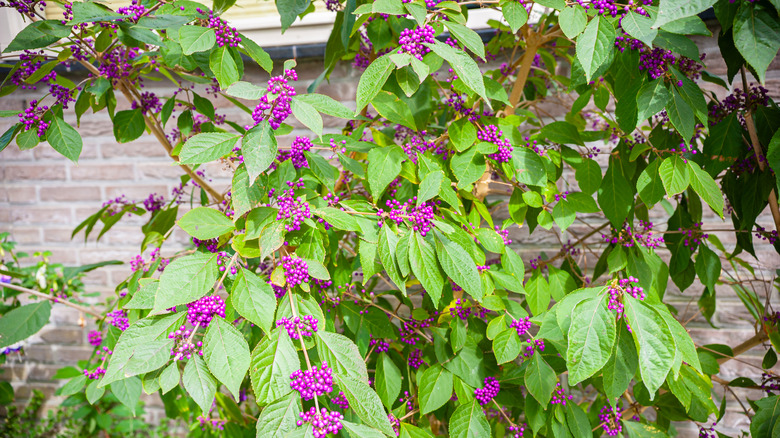The Bird-Loving Shrub To Prune In Late Winter For Better Spring Growth
Winter may spell the end of the task list for many gardeners, but that doesn't mean it's time to put away your trusty tools just yet. Cooling weather signals it's time to prune this specific shrub that birds just so happen to love for abundant spring growth. The American beautyberry (Callicarpa americana) is a berry-producing shrub that will keep birds and wildlife fed all fall and winter. This U.S. native perennial is also low-maintenance; gardeners can reap the benefits of this show-stopper without too much work. However, beautyberries aren't entirely hands off. You need to prune it each year to tailor its appearance and keep it healthy. Winter is a good time to undertake this chore because the flowers and berries form on new growth, which appears in the spring.
Choosing to prune your beautyberry shrub in the winter compared to other seasons may seem like unnecessary busywork, but it's a practice backed up by science. Once a shrub or tree matures, it has two types of growth: Branches that grew in previous seasons are called old growth (or wood), while new growth consists of the stems that will grow next season. Some plants produce flowers on old wood. Others, like beautyberries, bloom on new wood. If you prune away too much new growth on your beautyberry, it won't produce abundant flowers and berries. If your aim was to grow a shrub that will attract birds to your yard for fun feathered sightings, this won't help. Winter is the perfect time to trim away any unsightly, unhealthy, or too long old wood from your beautyberry without risk to new growth.
How to prune your American beautyberry shrub
Pruning your American beautyberry in early to late winter is a beginner-friendly project. It's something most people can do without hiring professional help, making it a budget-friendly solution to maintaining your landscaping. It's deciduous, so will be free from leaves in winter, making it very easy to identify which stems to cut. However, for the best results, you need the right tools: lightweight shears for thinning and heading stems, and shaping the shrub, and loppers or an electric hedge trimmer for more extensive pruning. Make sure, too, that your tools are thoroughly clean and sanitized before you get cutting.
If your aim is to attract birds, waiting until late winter to prune a beautyberry is best — you want to leave the small clusters of colorful flowers and, later, bright purple berries on the shrub as long as possible. When pruning your shrub, remember the three-D rule to properly prune your plants. This means removing any branches that are dead, diseased, or damaged first to boost the health of the plant. Has your beautyberry become unruly over the spring and summer? Once you've taken care of the three-Ds, it's time to shape your shrub. Trim away any branches that are overhanging garden beds or lawns, or sticking out at odd angles. Don't be too gentle with your tools: these shrubs survive just fine and even benefit if cut back almost to the ground.

